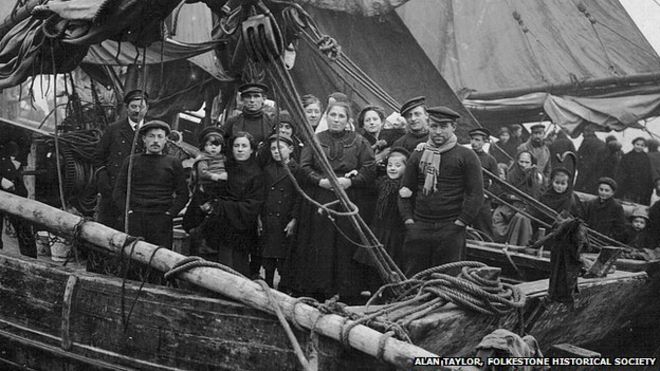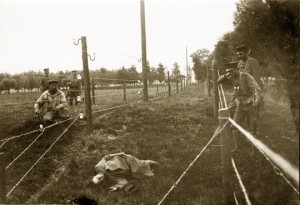War and peace in the Middle East and Europe
By Khaled Diab
Europe's history of total war and mass displacement can help create more sympathy for today's refugees and keep hope alive in the Middle East.

Tuesday 28 April 2015
Some 800 refugees lost their lives in the Mediterranean sea last week. While this has prompted calls for the European Union to do more to deal with the refugee crisis created by the current turmoil in the Middle East and North Africa, voices on the far-right have demanded that Europe do less.
Among them was Katie Hopkins, a popular columnist with UK tabloid The Sun, who has over half-a-million followers on Twitter. Shortly before the latest tragedy, she wrote a column in which she described these migrants as “cockroaches” and “feral humans,” suggesting outrageously: “What we need are gunships sending these boats back to their own country.”
On social media, the reactions were even more shocking and disgraceful. Supporters of the Dutch Partij voor de Vrijheid (Party for Freedom), or PVV, founded by the anti-immigrant firebrand Geert Wilders, expressed stomach-churning euphoria and ecstasy at the tragedy.
“600 fewer benefits,” one rejoiced.
“Good so. The more who drown, the fewer the problems,” another volunteered.
“Now the seabed is even more polluted,” joked yet another.
Judging by this small sample of comments, what has actually hit rock bottom are the moral compasses of many Dutch people and Europeans
Despite the clear racism of these comments, the European anti-immigrant right wing in general also taps into deep-seated public anxiety towards the violent upheavals and conflicts taking place in the Middle East, which many fear refugees might bring with them.
For some on the far-right, “refugees” and “asylum seekers” have become dirty words, terms of abuse and subjects of hate. While right-wing nationalists may claim to be defending their heritage and tradition, in their attitudes to refugees they are actually betraying it.
Europeans weren't always so hostile towards those fleeing war and conflict. During World War I, the Netherlands welcomed so many refugees that the Germans saw it necessary to construct a 200-kilometre-long fence along the Belgian-Dutch border in an effort to curb the influx of Belgians pouring from the German occupation into neutral Holland.

Source: http://www.dodendraad.org/index.php/wire-of-death
Known as the Wire of Death, it was the world's first-ever high-voltage electric barrier. Built at a time when Europeans were largely unaware of electricity and its attendant dangers, the fence claimed hundreds of victims who were unaware of how deadly it was or were desperate enough to risk death to cross the border.
In order to shorten the barrier's distance, German engineers took shortcuts that left large swathes of Belgian territory stuck in the no-man's land behind the fence. Like in the contemporary West Bank, this meant that a large number of farmers could not reach their land and many families and friends were forced to live in enforced separation. Using a system that would be familiar to modern-day Palestinians, the Germans only allowed those with hard-to-obtain passes, which excluded men aged 16 to 45, to cross the barrier.
This is a far cry from the current situation, where the Benelux countries (Belgium, Netherland and Luxembourg) are tightly integrated and even acted as a precursor and “experimental garden” for the EU. The Middle East, especially the former Ottoman Empire, has gone in the other direction. While the Levant was once largely a borderless economic and cultural area, with many mixed marriages and friendships, today many of its borders are tightly sealed, especially Israel's borders with Syria and Lebanon.
Many generations on, the vast majority of Belgians, including my wife and myself, are unaware that such a deadly barrier ever existed and almost no physical signs remain. In fact, I still remember clearly the first time I “crossed” between Belgium and Holland and my wife (girlfriend, at the time) challenged me to identify the border. As the two countries flow so seamlessly into each other, I failed.
It was not just the Dutch who gave refuge to their unfortunate Belgian neighbours. Even though Britain is famed for its oft-isolationist island mentality, it was, during World War I, home to a quarter of a million Belgian refugees, many of whom were housed in purpose-built villages.
Unlike today's image of asylum seekers as being spongers and cheats, these refugees were regarded as heroic and people wanted to help the “plucky Belgians.” It would be welcome if, instead of shirking its responsibilities, Europe rediscovered this spirit and took in more refugees today.
To understand the fundamental shift in attitudes over the ensuing decades, one needs to delve into the nature of contemporary (Western) Europe. It's not just a matter of selfishness and ill-will but also a question of profound misunderstanding.
It is said that the past is a foreign country, and the Europe of war and near-annihilation has become just that – a distant memory which only the oldest of Europeans has partly experienced first-hand. When viewed from the peaceful, still-largely prosperous and borderless European Union, the madness and mayhem in the Middle East and Africa seems inexplicable and barbaric, and this makes it far easier to blame the victims for the situation they find themselves in.
But the Europe of the First and Second World Wars resembled the contemporary Middle East to a frightening degree – except Europe was deadlier still.
While an estimated 3 million Syrians have fled the war that's ravaging their country, the situation is not unprecedented. A century ago, there were over 10 million refugees in Europe, while World War II resulted in tens of millions of displaced people.
A century ago, Belgium, like Syria today, was a devastated nation of refugees and internally displaced people. Some 1.5 million Belgians fled to neighboring countries, and possibly as many again sought refuge from the fighting in other parts of the country. And this was in a country of just over 7.5 million inhabitants.
To Europeans, another inexplicable aspect of the contemporary Middle East is the horrendous levels of mindless killing and blood-letting, which leaves the impression that our region has a unique bloodlust.
Though comparative carnage is a rather macabre undertaking, it is nonetheless a useful exercise to highlight, both to Europeans and Middle Easterners, that the current situation is not unique and, hence, can eventually be overcome.

While the carnage and destruction in Syria and the wider region today is horrendous and troubling, it pales in comparison with the butchery that took place on the Western Front, where the average trench soldier held onto life for just six weeks. The Battle of the Somme alone claimed over a million dead and wounded.
Despite the tens of millions of Europeans who perished in the two world wars, Europe was able to turn over a new leaf in its history and herald in an extraordinary era of peace and coexistence.
It is inevitable that the fire engulfing our region will eventually die down. I only hope that it happens sooner than it did in Europe, and that, out of the rubble of conflict, we draw similar lessons to those of the architects of the European Union, and construct a frontierless Middle Eastern Union.
____
Follow Khaled Diab on Twitter.
This is the extended version of an article which first appeared in Haaretz on 23 April 2015.


And another problem is the message of the EU as “a reconciled continent” which does not seem to be attractive anymore to young European citizens… Pascal Lamy in its latest book wrote “the memory of a past, even if very tragic, does not make a future”. Young generations of Europeans should never forget what happened and how many Europeans gave their life for peace and reconciliation, but at the same time we have to offer a new European speech to these younger generations in this period of crisis. A challenge
Good point. Peace is not just the absence of war. The main weakness of the EU is its growing neoliberlaism.
Very good article Khaled! Indeed, the EU has a lot to teach on how to overcome conflicts. In this sens the EU is unique in the world. But more than “peace and coexistence” the EU is a “reconciled” area. Many border countries in this world are in peace but they are far from being “reconciled”.